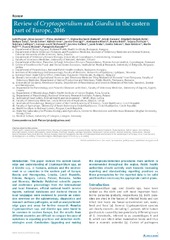Приказ основних података о документу
Review of Cryptosporidium and Giardia in the eastern part of Europe, 2016
| dc.creator | Plutzer, Judit | |
| dc.creator | Lassen, Brian | |
| dc.creator | Jokelainen, Pikka | |
| dc.creator | Đurković-Đaković, Olgica | |
| dc.creator | Kucsera, Istvan | |
| dc.creator | Dorbek-Kolin, Elisabeth | |
| dc.creator | Soba, Barbara | |
| dc.creator | Sreter, Tamas | |
| dc.creator | Imre, Kalman | |
| dc.creator | Omeragić, Jasmin | |
| dc.creator | Nikolić, Aleksandra | |
| dc.creator | Bobić, Branko | |
| dc.creator | Živicnjak, Tatjana | |
| dc.creator | Lucinger, Snježana | |
| dc.creator | Lazaric-Stefanović, Lorena | |
| dc.creator | Kucinar, Jasmina | |
| dc.creator | Sroka, Jacek | |
| dc.creator | Deksne, Gunita | |
| dc.creator | Keidane, Dace | |
| dc.creator | Kvac, Martin | |
| dc.creator | Huzova, Zuzana | |
| dc.creator | Karanis, Panagiotis | |
| dc.date.accessioned | 2021-04-20T12:58:24Z | |
| dc.date.available | 2021-04-20T12:58:24Z | |
| dc.date.issued | 2018 | |
| dc.identifier.issn | 1560-7917 | |
| dc.identifier.uri | http://rimi.imi.bg.ac.rs/handle/123456789/872 | |
| dc.description.abstract | Introduction: This paper reviews the current knowledge and understanding of Cryptosporidium spp. an d Giardia spp. in humans, animals and the environment in 10 countries in the eastern part of Europe: Bosnia and Herzegovina, Croatia, Czech Republic, Estonia, Hungary, Latvia, Poland, Romania, Serbia and Slovenia. Methods: Published scientific papers and conference proceedings from the international and local literature, official national health service reports, national databases and doctoral theses in local languages were reviewed to provide an extensive overview on the epidemiology, diagnostics and research on these pathogens, as well as analyse knowledge gaps and areas for further research. Results: Cryptosporidium spp. and Giardia spp. were found to be common in eastern Europe, but the results from different countries are difficult to compare because of variations in reporting practices and detection methodologies used. Conclusion: Upgrading and making the diagnosis/detection procedures more uniform is recommended throughout the region. Public health authorities should actively work towards increasing reporting and standardising reporting practices as these prerequisites for the reported data to be valid and therefore necessary for appropriate control plans. | en |
| dc.publisher | Eur Centre Dis Prevention & Control, Stockholm | |
| dc.relation | COST action [FA1408], A European Network for Food borne Parasites (Euro-FBP) | |
| dc.relation | Ministry of Science and Higher Education, Poland [NN308577039] | |
| dc.relation | Scandinavian-Baltic Society for Parasitology | |
| dc.relation | Estonian University of Life Sciences [8P160014VLVP] | |
| dc.relation | Romanian National Authority for Scientific Research and Innovation | |
| dc.relation | CNCS National University Research Council (CNCS) | |
| dc.relation | Executive Agency for Higher Education, Research, Development and Innovation Funding (UEFISCDI) [PN-II-RU-TE-2014-4-1300] | |
| dc.relation | Czech Science FoundationGrant Agency of the Czech Republic [15-01090S] | |
| dc.relation | info:eu-repo/grantAgreement/MESTD/Integrated and Interdisciplinary Research (IIR or III)/41019/RS// | |
| dc.relation | One Thousand Talents Plan of the Chinese Government [WQ2013630172] | |
| dc.rights | openAccess | |
| dc.rights.uri | https://creativecommons.org/licenses/by/4.0/ | |
| dc.source | Eurosurveillance | |
| dc.title | Review of Cryptosporidium and Giardia in the eastern part of Europe, 2016 | en |
| dc.type | article | |
| dc.rights.license | BY | |
| dc.citation.epage | 43 | |
| dc.citation.issue | 4 | |
| dc.citation.other | 23(4): 21-43 | |
| dc.citation.rank | aM21 | |
| dc.citation.spage | 21 | |
| dc.citation.volume | 23 | |
| dc.identifier.doi | 10.2807/1560-7917.ES.2018.23.4.16-00825 | |
| dc.identifier.fulltext | http://rimi.imi.bg.ac.rs/bitstream/id/674/869.pdf | |
| dc.identifier.pmid | 29382412 | |
| dc.identifier.scopus | 2-s2.0-85041900704 | |
| dc.identifier.wos | 000423449800003 | |
| dc.type.version | publishedVersion |

